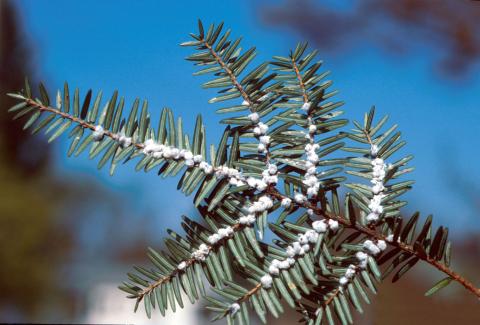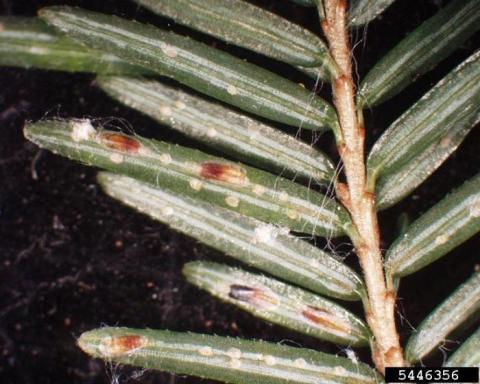
For the love of hemlocks Tiny insects target mighty gaagaagimizhiin
By GLIFWC Invasive Species Coordinator, Steve Garske
Everyone loves gaagaagimizh, or eastern hemlock tree. White-tailed deer (waawaashkeshi) love gaagaagimizhiin (hemlock trees) for the food and cover they provide in winter. Gaagwag (porcupines) love the salty taste of their branches. Hermit thrushes, Acadian flycatchers and several species of warblers love them for their dense canopies that support a variety of insects and mites.
Brook trout (maazhamegoonsag) and their invertebrate prey benefit from the cool streams shaded by gaagaagimizh. Beings ranging from blue jays (diindiisiwag) to deer mice (waawaabiganoojiinyag) and southern red-backed voles enjoy the nutritious seeds that hemlocks produce every summer. The moist, sheltered environment created by stands of gaagaagimizh provides important habitat for more than 120 birds and mammals and over 300 species of insects and other arthropods.
In the northeastern United States, at least eight bird and 10 mammal species are strongly associated with hemlock forests. Humans enjoy the graceful form and attractive deepgreen foliage of gaagaagimizh and its relatives. So much so, that they’ve even imported hemlocks (Tsuga spp.) and other conifers from overseas. This has enabled two more hemlock-loving beings to arrive in North America. Both are insects related to aphids or “plant lice,” and live on the stored nutrients of hemlock trees.
Troublesome Imports
An insect called the elongate hemlock scale (Fiorinia externa) or EHS, arrived in New York from Japan around 1908. It prefers hemlock but also feeds on other conifers, including balsam fir (aninaandag), black spruce (zesegaandag) and white spruce (gaawaandag). Juvenile EHS attach themselves to the undersides of the needles of these trees, where the females cover themselves in a hard, brown, waxy coating. They feed on nutrients from the needles, causing them to turn yellow and drop off. Heavy EHS feeding makes the host trees more susceptible to drought and diseases, and can eventually kill them.

In the northeastern United States, at least eight bird and 10 mammal species are strongly associated with hemlock forests. Humans enjoy the graceful form and attractive deepgreen foliage of gaagaagimizh and its relatives. So much so, that they’ve even imported hemlocks (Tsuga spp.) and other conifers from overseas. This has enabled two more hemlock-loving beings to arrive in North America.
Both are insects related to aphids or “plant lice,” and live on the stored nutrients of hemlock trees. Troublesome imports An insect called the elongate hemlock scale (Fiorinia externa) or EHS, arrived in New York from Japan around 1908. It prefers hemlock but also feeds on other conifers, including balsam fir (aninaandag), black spruce (zesegaandag) and white spruce (gaawaandag). Juvenile EHS attach themselves to the undersides of the needles of these trees, where the females cover themselves in a hard, brown, waxy coating. They feed on nutrients from the needles, causing them to turn yellow and drop off. Heavy EHS feeding makes the host trees more susceptible to drought and diseases, and can eventually kill them.
The second, much more destructive introduction is the hemlock woolly adelgid (Adelges tsugae), or HWA.
This tiny insect is native to central and eastern China, South Korea, Taiwan, Japan, and the Pacific Northwest. At least eight genetically distinct “lineages” of HWA occupy different parts of this range, and vary in life cycle and host specialization. The eight species of hemlock trees (including mountain hemlock and western hemlock of western North America) that inhabit this range are naturally resistant to this insect. On top of that, various specialist insects and diseases keep the HWA in check. But this isn’t the case in eastern North America, where the HWA is a recent arrival. The HWA was first detected in eastern North America in Richmond, Virginia in 1951. From there it has spread throughout most of the range of eastern hemlock (Tsuga canadensis) and Carolina hemlock (T. caroliniana), from northern Alabama and Georgia north to New York and southern Maine, with an outlier population in western Lower Michigan. Using genetic testing, researchers have found that this introduced HWA lineage came from southern Japan. Unfortunately these two eastern hemlock species have little resistance to the HWA, and natural HWA predators are absent from their range. As a result the HWA has caused extensive hemlock decline and mortality in eastern North America. Pushing back with biocontrols Since the 1990s a major effort has been underway to introduce insect predators from Asia and western North America to control the HWA in eastern North America. The most successful so far have been two species of Laricobius beetles, one from the western US and the other from Japan. Both are now widely established across eastern North America, where they feed heavily on the winter nymphs of HWA. Unfortunately, the HWA reproduces at such high rates that these two beetles (along with another Laricobius that’s native to eastern North America and typically feeds on a spruce adelgid) haven’t reduced HWA numbers significantly. At least not yet. Several species of flies that specialize on adelgids are currently being evaluated for host-specificity and effectiveness at controlling the HWA. These should work together well with the Laricobius beetles, because they emerge in spring and prey on both generations of HWA. Because the Michigan infestations were initiated by infested hemlock trees shipped from out east, Michigan has implemented an HWA interior quarantine. The law regulates the movement of hemlock and tiger-tail spruce trees (Picea torano, the alternate host for the introduced lineage of HWA), along with forest products and nursery stock from the infested counties to other parts of the state. It has also implemented an exterior quarantine, regulating the movement of materials from other states with infestations. Meanwhile the Wisconsin Department of Agriculture, Trade and Consumer Protection (DATCP) has placed an exterior quarantine on items that could carry EHS and HWA. These quarantines restricts the import of the EHS and HWA, along with hemlock trees, bark, and a variety of other conifers from infested eastern states including Michigan. (Mazina'igan Summer 2024).